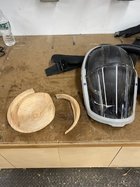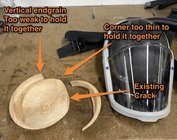As you can see in the picture below, I had a bowl come apart on me. Luckily, I was wearing a face shield, so when the bowl came off it bounced off the shield and came to rest a few feet away. I’m trying to understand what happened, to try and not do it again.
This was a rough turned elm bowl about 7-1/2” in diameter. It had been drying for almost 10 years. I had turned a recess on the inside of the bowl and had it mounted on 5” dovetail jaws in expansion mode, so that I could practice my 40/40 style grind push cuts on the outside without the tailstock in the way.
I had finished the last of the finishing cuts and was about the stop the lathe when the bowl came apart. I was turning at approx. 800 RPM, so I don’t think I was turning at an excessive speed for the size of the bowl. When the bowl came apart, I wasn’t making any cuts at the time, the bowl was just spinning, so it wasn’t catch induced which would be easier to understand.
Thoughts on what might have cause the failure. My thoughts so far are: 1/I put too much pressure when I expanded the jaws and as I thinned the wall with cuts it was just too much force, 2/there was a crack I didn’t see from drying and as I thinned the wall it let go? Other ideas? Precautions I should take on the next one I turn this way?

This was a rough turned elm bowl about 7-1/2” in diameter. It had been drying for almost 10 years. I had turned a recess on the inside of the bowl and had it mounted on 5” dovetail jaws in expansion mode, so that I could practice my 40/40 style grind push cuts on the outside without the tailstock in the way.
I had finished the last of the finishing cuts and was about the stop the lathe when the bowl came apart. I was turning at approx. 800 RPM, so I don’t think I was turning at an excessive speed for the size of the bowl. When the bowl came apart, I wasn’t making any cuts at the time, the bowl was just spinning, so it wasn’t catch induced which would be easier to understand.
Thoughts on what might have cause the failure. My thoughts so far are: 1/I put too much pressure when I expanded the jaws and as I thinned the wall with cuts it was just too much force, 2/there was a crack I didn’t see from drying and as I thinned the wall it let go? Other ideas? Precautions I should take on the next one I turn this way?


